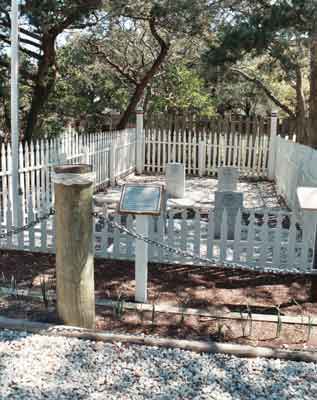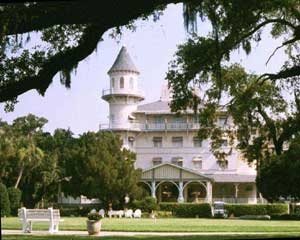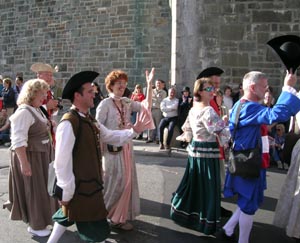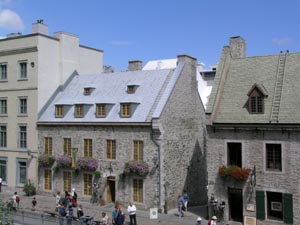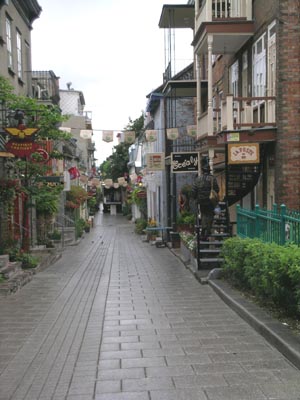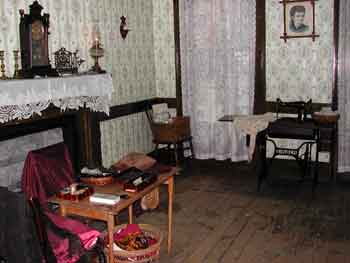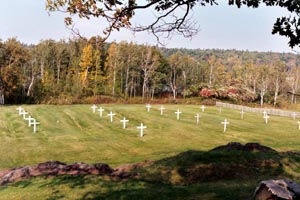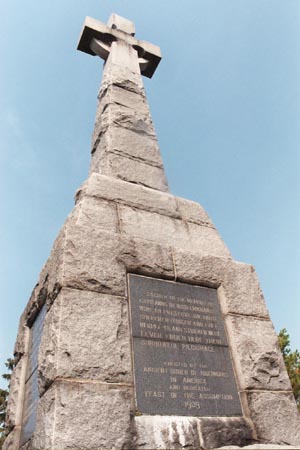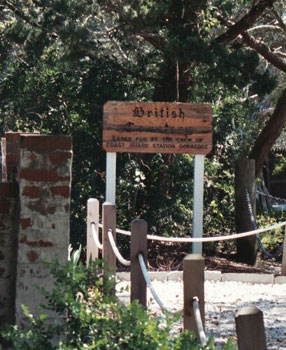 |
Experiencing
History First-hand When I went to school, history was one of my least favorite subjects: I found it dry, boring and filled with meaningless dates that I plodded through somewhat resentfully. Then I discovered historical fiction and realized that history isn’t just dates; it’s the actions of people. It’s the way their passions and beliefs play out on a grand stage. And then I discovered historical travel — and I was hooked. I also began to discover that behind every place there is a particular story that resonates with me on a personal level. And now I know that sometimes that story illuminates a tiny portion of something I already knew. |
||
The British Cemetery of Ocracoke Island, North Carolina We all know the about the events of the Second World War; we’ve seen the movies, read the books, studied it in school. But just when we think there’s nothing more to know, we discover (or re-discover) some special event or place — like the British Cemetery on Ocracoke Island. And there are also the memorial services held there on the Thursday and Friday closest to May 11th; when British and American veterans meet on British soil — in North Carolina. The memorial service honors British sailors buried in a piece of land deeded by the U.S. government to Britain on the island of Ocracoke in the Outer Banks, North Carolina. It's a story of heroism and gratitude. And it begins in May of 1942, shortly after the attack on Pearl Harbor. The United States had been pulled into the war. We were fighting the Japanese in the Pacific, and Europe was being pummeled by the German Luftwaffe. But the shores of the continental United States and Canada were far from safe. In fact, from January to May, 1942, German U-boats shadowed our coastlines and sunk our merchant ships. And the proof was in the debris which washed up nightly on the shores of the Outer Banks of North Carolina. The German strategy was to batter the British, making it difficult for them to produce manufactured goods, and to destroy our shipping lanes, making it impossible for Canadian and American manufacturing companies to supply our allies overseas with oil, iron, lumber, food stuffs, and more. The United States in particular was not well-prepared to defend against the German attack, especially given the 2500-odd miles of coastline from Maine to New Orleans. So, protection, initially, came not from our own armed forces but from our British allies with the loan of deep-sea trawlers, refitted with mine-sweeping equipment, a device designed to detect submerged objects, like submarines; as well as depth-charges to attack the German U-boats. In early May the British naval vessel HMCS Bedfordshire's mission was to escort a small band of merchant ships to safe anchorage in Hatteras. As they often do in wartime, events grow murky after that. What is known however is that on the morning of May 14, 1942 the bodies of two sailors washed up on the shores of Ocracoke Island. They were identified by a local, Aycock Brown, as being from the Bedfordshire. Brown had actually met one of the sailors by chance weeks earlier. Papers found on the bodies confirmed their identities as crewmen from the ship. What to do? Initially they were buried in a donated space in the cemetery. Although no official group had responsibility for the cemetery, many of the people of Ocracoke had loved ones serving in the armed forces and felt a kinship and gratitude to the sailors buried there. Eventually a lease for the tiny 2290-square-foot plot was given to the Commonwealth War Graves Commission for as long as the land remained a cemetery; and the plot officially became a British cemetery. Today the United States Coast Guard station at Ocracoke maintains the property, and a British flag flies at all times over the graves of those British sailors. The land is essentially British territory. It has been given in honor of the men buried there so that they can rest in “home” soil. And each year Americans and British gather in this cemetery to honor the men who died protecting our shores. A plaque at the Ocracoke cemetery contains part of the poem by the famed pre-World War One British poet Rupert Brooke:
And indeed it is. Read Neala's full article on Okracoke Island by clicking here. Visit the Ocracoke Island webpage by clicking here. Take a walking tour of Okracoke Island by clicking here. Jekyll Island, Georgia Sometimes history is just plain fun. It’s a glimpse of a lifestyle we’ll never attain or experience. It’s Lifestyles of the Rich and Famous — the historical variety. My particular vicarious lifestyle experience takes place on Jekyll Island off the coast of Georgia. The historic district of Jekyll Island is very charming, composed of the winter “cottages” built by the likes of JP Morgan. And if that isn’t enough, there is a church here with a stained glass window made and installed personally by Louis Comfort Tiffany. It began in 1886 when a group of incredibly wealthy men with names like Vanderbilt, Rockefeller, and JP Morgan bought the island. They intended to use the island as a “members only” private preserve and hunting club during the winter months, and erected a clubhouse and apartments where members could stay. If something more private and permanent was desired, members could build their own individual cottages. And they did, creating a whimsical landscape of styles from Victorian with ornate trim to austere stone castles. Each of these “cottages” has its own personality and style. No zoning regulations reined in these incredibly wealthy families. Whatever took their fancy, they built. The buildings and the outbuildings (for example, power plants, tiny cabins for staff, etc.) make up the unusual historic district. Not all the cottages have survived, but several have been restored and others are in the process of being renovated. Jekyll Island is a delightful area to visit and experiencing a well-deserved renaissance as a tourism destination. Part of the reason is the colony of cottages that still grace Jekyll Island. The mansions of Newport, Rhode Island are grander by far, but they lack the acres of land on which you can roam to experience the island — not only its cottages, but the church with the stained glass by Tiffany, the outbuildings now tiny shops, and the paths leading through the acres of trees and to the water. It’s a glimpse of a historic lifestyle, that will likely never be seen again. |
|
||
Read Neala's complete article on Jekyll Island by clicking here. Visit the Jekyll Island website by clicking here. The Lower East Side Tenement Museum, New York City And at the other end of the economic spectrum is the Tenement Museum in New York City; part of the National Trust for Historic Preservation. You can find it at 97 Orchard Street;an actual tenement building dating back to 1863. Several apartments have been renovated “backwards” to recreate the life and living conditions of various immigrant groups. During guided tours to the recreated apartments, you see how families lived during the great Depressions of 1873 and 1929. The garment industry figures prominently in the history of the Lower East Side, and the museum's “Piecing It Together” is a special narrated tour that tells the story of the times through two families: one operated a garment shop in their home and the other's principal income came from work as a presser in a factory. “The Confino” is a particularly engaging and interactive tour. Visitors tour the living quarters of the Confino family, pretending to be newly arrived immigrants in the year 1916. Victoria Confino, the daughter of the family, is off from work and has agreed to mentor us as newly arrived immigrants. On our tour the costumed historical interpreter chatted for 45 minutes about the reasons her family moved from Kastoria (in what is now Greece), about the voyage, and about the rigours of immigration. She helpfully explained to us about the public baths (no bathing facilities were available in the building), and the necessity of using a chamber pot at night. (There was no lock on the door to the building and so the two bathrooms that served the entire floor were not safe after dark.) Reservations for the tours should be made in advance. Free parking (almost unheard of in New York) is available through the Lower East Side Business Improvement District. The museum also offers a film and regularly scheduled exhibits, and plays, and walking tours of the area. Read Neala's full article on the Lower East Side Tenement Museum. Visit the website of the Lower East Side Tenement Museum. La Basse Ville and la Place Royale of Québec City, and La Nouvelle France What if you could not only visit historic buildings from past centuries but also don the clothes of the period and walk through the streets, as if you were living in the time period? The Nouvelle France festival in Québec City takes place in August, and celebrates the French heritage of the Québécois in Canada's predominantly French-speaking province. In the province's capital city you will discover pure, preserved history; and the geographic setting is perfect. At the heart of this historic city is Place Royale, the actual site of the first capital city in New France when the fur-trading colony of France extended far into the North American continent and south to the Gulf of Mexico. (This was long before the Louisiana Purchase.) The Place Royale is noted for its authentic historical treasures and its charming, wandering streets. The history of Place Royale is the focal point of Old Québec. Located in the Basse Ville (this Lower Town was the principal port on the St. Lawrence River and older than the Haute Ville/Upper Town). By 1680 Place Royale was the commercial center of the French trading empire. But fires, cannon bombardment during the Battle of the Plains of Abraham when the British turned the tide of North American history by taking the colony from France (La Conquête or The Conquest), more fires, and even 20th-century urban blight had reduced this historic area to a waterfront slum. In 1960 the government of Québec embarked on a program to reconstruct the area and convert it to an open-air community of vibrant living history. The new Place Royale is based on plans and decrees from the 1700s, and the buildings have been rebuilt in a Norman style construction modeled after the original homes of wealthy merchants of the colony. Fires were a major concern 400 years ago, so the buildings were constructed of stone with firewalls between buildings and ladders on the mansard roofs. When a chimney fire occurred it would be easy to climb up the roof and douse it. Today, the buildings have antique stores, chic restaurants, and other arts-oriented shops on the lower floor and exclusive housing (with modern conveniences) on the upper floors. The Basse Ville is also where some of the most charming and historic boutique hotels are located. It feels like a small French village complete with cobblestones and authentic 18th-century buildings. It’s a good way to immerse yourself in the history, culture, and architecture of the former French Régime in North America. Read Neala's full article on Québec City. Visit Québec City's official website. Pay a virtual visit to Place Royale with state-of-the-art website technology. Grosse Île and the Irish Memorial National Historic Site of Canada Both Canada and the United States of America are largely countries of immigrants. Except for our indigenous peoples, we all are descendents of someone who came from somewhere else. If the Tenement Museum in New York City describes what life was like for many after arriving in the United States, Grosse Île, Québec describes the very difficult experiences that Irish immigrants underwent during their immigration to a new homeland; they escaping the potato famine and a typhoid epidemic . At first the blue waves lapping at the edges of the island (Grosse Île means large island) suggest a bucolic retreat complete with walking paths up and down the hills. But instead, Grosse Île is part memorial and part fascinating exhibit about the often painful and long-suffering process of immigration. It opened as an immigration station in 1832 and closed in 1937, almost 100 years later. Although the island was used for other purposes, it is the 100-year period during which it was an immigration and quarantine station that is the focus of its sad yet fascinating history. In 1832 Canada needed settlers, particularly for the western provinces, but cholera was raging through Europe and the British couldn’t risk inadvertently “importing” an epidemic. New arrivals to Canada who were already ill or who had been exposed to disease were quarantined on Grosse Île until they were free of disease. Sadly Grosse Île became the quarantine station, but for many it was their first and last stop in Canada. (Unfortunately, Louis Pasteur had not yet discovered the existence of germs and bacteria.) During the years of the Potato Famine (1845 to 1870) Irish immigrants flocked to Canada — the trip from Liverpool to Québec City, one of the first major ports of disembarkation, was cheaper than the voyage from Liverpool to New York. Of the Irish immigrants escaping the famine, 5000 died en route to Canada and were buried at sea. Thousands more would die after being quarantined on Grosse Île between May and October of 1847. The year came to be known as “Black 47.” Escaping the famine to Québec however, didn’t enable many of these immigrants to escape typhus infections — typhoid fever followed them across the ocean and in those few months 5524 men, women and children died. Incredible overcrowding help spread the disease. The island had been set up with beds and space for only about 1000. During 1847 however, over 12,000 people landed on Grosse Île. Just under 1000 people died each month. They could barely keep up with burying the dead. Today on Grosse Île there is a memorial in the shape of a Celtic cross with plaques on each of the four sides of the base. It was built in 1909 by people of Irish descent who raised the money in memory of their countryfolk. The monument is not without controversy, however. One side of it refers (in Celtic) to people fleeing from an “artificial famine” created when Ireland was exporting food to England — even as its own people starved. The passage ends with “God Save Ireland.” Plaques on the other sides remember the doctors and priests who also died during the typhus epidemic. Grosse Île was designated a national historical site by the Canadian government in 1989. Today tours include a walk through part of the island. A narrated trolley tour goes through the village where the staff, carpenters, drivers, medical personnel, priests and teachers lived and worked. Many buildings have been destroyed and others are in disrepair. Eventually the government hopes to restore them sufficiently for interior tours. At the critical core of the immigration and quarantine process on Grosse Île is the disinfection building. Walking through the old wooden structure, visitors use headphones through which they hear dramatized statements by men and women recalling their experiences. Through this audio technology, visitors to Grosse Île today are also put in the role of the immigrants and hear the voices of those in charge telling them what to do and how the disinfection will proceed. All this is programmed to specific rooms being visited; as you walk from room to room the content changes. The voices, sensations, and atmosphere in the long cavernous building containing shower cubicle after cubicle is especially powerful. And the huge steam rooms where the immigrants' clothes were disinfected are equally poignant. By the early 1900s, medicine had advanced. Hotels were constructed on the island so that people who were not ill could stay while family members went through quarantine and treatment. Small pox vaccines were given to those who were healthy and treatment in the hospital was given to those who were ill. Eventually a first-class hotel was built on the island as well as second- and third-class accommodations. Although none are currently open, plans are being made to restore the first-class hotel as part of the tour. Immigration was essential to the development of North America; it was the men, women, and children who left Europe under duress who continude to populate Canada and the United States. Coming face to face with the conditions under which they lived here initially, and understanding their concerns, experiences, hopes, and fears puts a human face on the suffering that was a part of the development of both nations. Read more about Grosse Île on the Parks Canada website by clicking here. Click here for the Web-based Atlas of Canada which shows the location of Grosse Île. Throughout North America there are many more amazing historical sites where you can learn history experientially. For example, you can visit the pueblos of New Mexico where some people choose to live as they did hundreds of years ago. Hampton, Virginia is also one of those “hands on” historical sites where the lives of the people were so greatly affected by the Civil War. After visiting sites like Ocranoke Island, Jekyll Island, the Tenement Museum in New York City, Place Royale in Québec City, and Grosse Île, you’ll never think of history the same way again. |
|||
